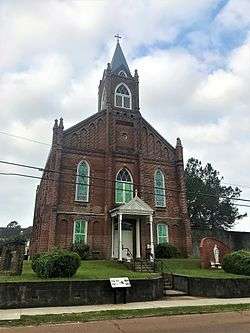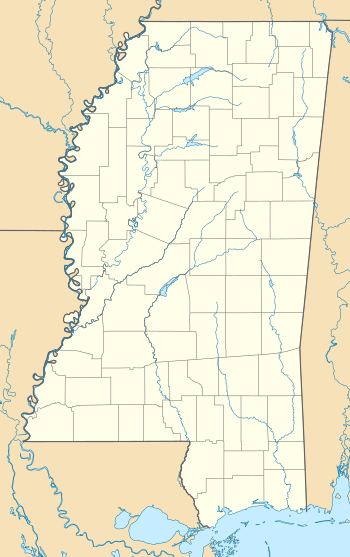Holy Family Catholic Church Historic District
The Holy Family Catholic Church Historic District, in Natchez, Mississippi, is a 9.2-acre (3.7 ha) historic district that was listed on the U.S. National Register of Historic Places (NRHP) in 1995. The district is small, relative to other historic districts in Natchez such as the Natchez On-Top-of-the-Hill Historic District which is adjacent, on the west. Its most significant building is the Holy Family Church, the first African-American Catholic church in the state; dedicated in 1894, it is Natchez's best piece of Gothic Revival architecture. Most other buildings in the district are cottages in Queen Anne, Eastlake, Colonial Revival, bungalow, and American Craftsman architectural styles. The district as a whole is significant for its architecture and for its African-American historical associations.[2]
Holy Family Catholic Church Historic District | |
 Holy Family Church | |
  | |
| Location | Roughly along Aldrich, Old D'Evereux, St. Catherine, Abbott and Byrne Sts., Natchez, Mississippi |
|---|---|
| Coordinates | 31°33′34″N 91°23′46″W |
| Area | 9.2 acres (3.7 ha) |
| Built | 1886 |
| Architect | Ketteringham, William K. (Holy Family Church) |
| Architectural style | Greek Revival, Italianate, Queen Anne |
| NRHP reference No. | 95000855[1] |
| Added to NRHP | July 14, 1995 |
The listing included 49 contributing buildings and one other contributing site. It includes Greek Revival, Italianate, and Queen Anne architecture.[1]
The area is a historically black neighborhood, like the Woodlawn Historic District, also NRHP-listed, nearby. The district is a cluster of buildings near to the Holy Family Catholic Church, which is on St. Catherine St., which was originally the old Natchez Trace.[2]
Other city districts
There are several other NRHP-listed historic districts in Natchez:[1]
- Natchez On-Top-of-the-Hill Historic District, abutting the Holy Family HD on the west, and south of the Upriver HD
- Upriver Residential District, adjacent to the Woodlawn HD, on the west
- Woodlawn Historic District, another historically black neighborhood historic district (HD)
- Natchez Bluffs and Under-the-Hill Historic District, on river side of On-Top-of-the-Hill HD
- Downriver Residential Historic District, further south below the On-Top-of-the-Hill HD
- Clifton Heights Historic District, on the river side of the Upriver HD
- Cemetery Bluff District
References
- "National Register Information System". National Register of Historic Places. National Park Service. July 9, 2010.
- Mary Warren Miller (February 17, 1995). "National Register of Historic Places Registration: Holy Family Catholic Church Historic District". National Park Service. and accompanying photos